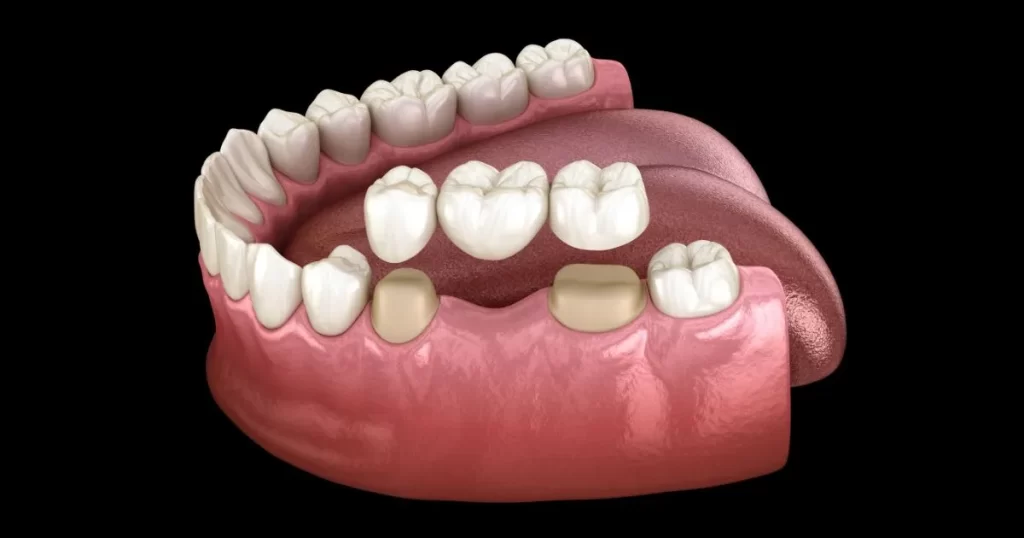Traditional Bridge
- Home
- Dental Bridges
- Traditional Bridge
If you have missing teeth, you may be considering a dental bridge as a way to restore your smile. A traditional bridge is a dental prosthesis that is used to replace one or more missing teeth. It is a popular and effective option for restoring the appearance and function of your teeth. In this article, we will explore traditional bridges in more detail, including their benefits, how they work, and what to expect during the procedure.

Traditional dental bridges are a type of dental prosthesis that is used to replace one or more missing teeth. They consist of a false tooth, known as a pontic, which is held in place by dental crowns that are cemented onto the teeth adjacent to the gap. The dental crowns are also known as abutment teeth, and they serve as anchors for the bridge.
Traditional bridges can be made from a variety of materials, including porcelain, ceramic, and metal alloys. Porcelain and ceramic bridges are the most popular choices, as they offer a natural-looking and durable solution for missing teeth.
Traditional bridges offer a range of benefits for people with missing teeth, including:
Improved appearance: Traditional bridges are designed to look and feel like natural teeth, restoring your smile and boosting your confidence.
Restored function: Bridges can improve your ability to chew and speak properly, which can improve your overall quality of life.
Preservation of remaining teeth: By filling the gap left by missing teeth, traditional bridges can prevent adjacent teeth from shifting out of position and causing further dental problems.
Long-lasting solution: With proper care and maintenance, traditional bridges can last for many years, providing a durable and effective solution for missing teeth.
Before a traditional bridge can be placed, your dentist will need to prepare the abutment teeth by removing a small amount of enamel. This is necessary to make room for the dental crowns that will hold the bridge in place.
Once the abutment teeth have been prepared, your dentist will take impressions of your teeth, which will be used to create a custom bridge. This process may take several weeks, during which time you may be given a temporary bridge to wear.
Once the custom bridge has been created, your dentist will place it onto the abutment teeth and check the fit and appearance. If necessary, adjustments can be made to ensure a comfortable and natural-looking fit.
Once the bridge has been properly fitted, it will be permanently cemented onto the abutment teeth. Your dentist will provide you with instructions on how to care for your bridge, which may include regular brushing and flossing, as well as regular dental check-ups.
Getting a traditional dental bridge typically involves several visits to the dentist over a period of several weeks. During the first visit, your dentist will prepare the abutment teeth and take impressions of your teeth. You may be given a temporary bridge to wear while the custom bridge is being created.
During the second visit, your dentist will place the custom bridge onto the abutment teeth and check the fit and appearance. Once the bridge has been properly fitted, it will be permanently cemented onto the abutment teeth.
The procedure itself is typically painless, as your dentist will use a local anesthetic to numb the area around the abutment teeth. After the procedure, you may experience some mild discomfort or sensitivity, but this should subside within a few days.
Proper care and maintenance of your traditional dental bridge is essential to ensure its longevity and effectiveness. Here are some tips to help you care for your traditional bridge:
Brush twice a day: Brush your teeth twice a day with a fluoride toothpaste, paying special attention to the area around the bridge. Use a soft-bristled toothbrush to avoid damaging the bridge or the surrounding teeth.
Floss daily: Flossing is essential for removing food particles and plaque from between your teeth and around your bridge. Use a floss threader to get the floss underneath the bridge and between the abutment teeth.
Avoid hard or sticky foods: Hard or sticky foods can damage your bridge or dislodge it from the abutment teeth. Avoid chewing on ice, hard candy, and other foods that can put undue stress on your bridge.
Visit your dentist regularly: Regular dental check-ups are essential for maintaining good oral health and ensuring the longevity of your bridge. Your dentist will check the fit and condition of your bridge and make any necessary adjustments or repairs.
Consider a mouthguard: If you play sports or grind your teeth at night, consider wearing a mouthguard to protect your bridge and your teeth.
If you have one or more missing teeth and are considering a dental bridge, traditional dental bridges may be a good option for you. They offer a natural-looking and durable solution for missing teeth, and they can improve your appearance, function, and overall oral health.
However, traditional dental bridges are not suitable for everyone. Your dentist will evaluate your oral health, dental history, and other factors to determine if a bridge is the right choice for you. They may recommend other options, such as dental implants or partial dentures, depending on your specific needs and preferences.
Traditional bridges are a popular and effective solution for replacing one or more missing teeth. They offer a range of benefits, including improved appearance, restored function, and preservation of remaining teeth. With proper care and maintenance, they can provide a long-lasting and durable solution for missing teeth.
If you are considering a traditional dental bridge as a way to restore your smile, talk to your dentist about your options. They can help you determine if a bridge is the right choice for you and provide you with the information and support you need to make an informed decision about your oral health.

